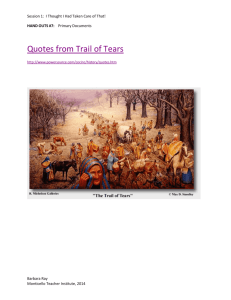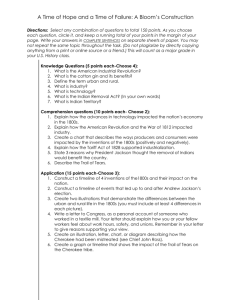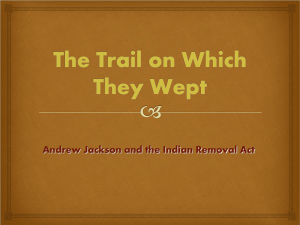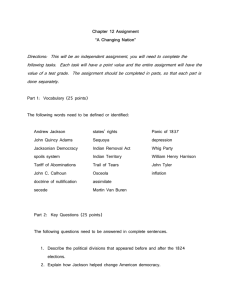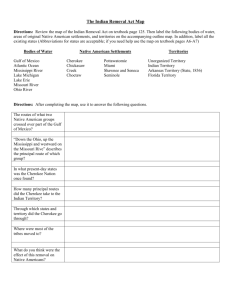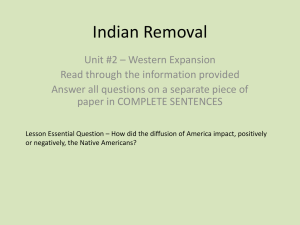the lesson file - Teaching American History: Freedom
advertisement
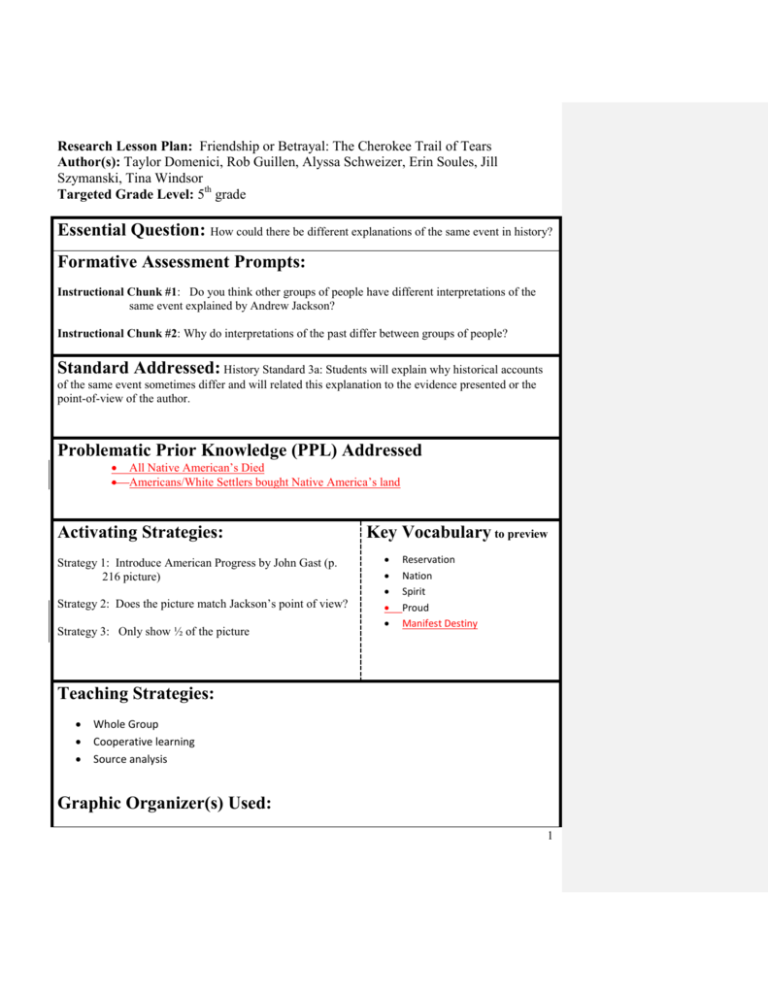
Research Lesson Plan: Friendship or Betrayal: The Cherokee Trail of Tears Author(s): Taylor Domenici, Rob Guillen, Alyssa Schweizer, Erin Soules, Jill Szymanski, Tina Windsor Targeted Grade Level: 5th grade Essential Question: How could there be different explanations of the same event in history? Formative Assessment Prompts: Instructional Chunk #1: Do you think other groups of people have different interpretations of the same event explained by Andrew Jackson? Instructional Chunk #2: Why do interpretations of the past differ between groups of people? Standard Addressed: History Standard 3a: Students will explain why historical accounts of the same event sometimes differ and will related this explanation to the evidence presented or the point-of-view of the author. Problematic Prior Knowledge (PPL) Addressed All Native American’s Died Americans/White Settlers bought Native America’s land Activating Strategies: Strategy 1: Introduce American Progress by John Gast (p. 216 picture) Strategy 2: Does the picture match Jackson’s point of view? Strategy 3: Only show ½ of the picture Key Vocabulary to preview Reservation Nation Spirit Proud Manifest Destiny Teaching Strategies: Whole Group Cooperative learning Source analysis Graphic Organizer(s) Used: 1 4 square graphic organizer I know /I wonder Chart Materials Needed: Packet of Hand Outs #2-4 made for each student. Consists of o John G. Burnett’s story of the removal of the Cherokees o Trail of Tears poem o Indian Reservation Poem Jackson Warns the Seminoles Letter( Handout #1) American Progress by John Gast (Image located on Power Point) PowerPoint on American Progress One graphic organizer per student: o I know/I wonder Chart (Appendix #1) o Point of View Graphic Organizer ( Appendix #2) Comment [DT1]: Added Comment [DT2]: Added Differentiation Strategies: Students will be paired in groups of 3 -4; heterogeneous groups Instructional Plan: Instructional Chunk #1: How could there be different explanations of the same event in history? 1. Procedures: Procedures: Activating Prior Knowledge 2. Teacher will poll students on their knowledge of the “Cherokee Trail of Tears” Indian Removal by asking them to list what they know on the provided “I know/I wonder” graphic organizer (Appendix 1: I know/I wonder). Students will also write what they wonder about the Cherokee Trail of Tears. Group Instruction 3. Teacher will pass out “Jackson warns the Seminoles” (Handout # 1) to all students. 4. The teacher will allow students to read through the letter and discuss the meaning for a few minutes in cooperative learning groups of 3to 4 students. 5. The teacher will read aloud the given source and will pause every few lines discussing what Andrew 2 Jackson meant and discussing his point of view; occasionally asking for student feedback. 6. The teacher will model how to place the key points of Jackson’s point of view on the Point of view graphic organizer(Appendix 2: Point of View Graphic Organizer) 7. Debrief: ask the students… What is Andrew Jackson’s point of view towards the removal of Indian tribes? Making a Prediction: Do you think other groups of people, such as the Cherokee Indians or American Settlers, have the same point of view? Explain. 8. Check for Understanding/Summarizing Activity: The teacher will ask student to share what they have placed on their graphic organizer. Instructional Chunk #2: After reading Andrew Jackson’s letter to the Seminoles, explain his point of view of Indian Removal. 9. Procedures: ; The teacher will place on the projector the picture of American Progress by John Gast. The teacher will connect students to the theme of point of view by asking the students if it matches Jackson’s Point of view and will ask students to share; using the provided PowerPoint. The teacher will then cover half of the picture displaying the side of the angel and American settlers expanding west and will ask students to explain what they see and the point of view. The teacher will then cover the other half of the picture exposing the side of the Native Americans fleeing from the land and will ask students to explain what they see and the point of view. The teacher will ask “how has the author portrayed two points of view in one painting?” The teacher will ask if the picture portrays Jackson’s Point of View again by asking “Do you think the image reflects Andrew Jackson’s Interpretation of the removal of Native Americans? The teacher will inform students that they will use primary and secondary sources to analyze different points of view on about the Cherokee Trail of Tears and Indian Removal The teacher will pass out a packet containing Handouts 2 and 4 to each student. The teacher will instruct students to get out their Point of View Graphic Organizer (Appendix 2) and review what Andrew Jackson’s point of view was. The teacher will allow students to work in cooperative groups of about 4 students to review Hand outs 2-4, other sources. Students will work together reading and analyzing the documents. Students will write down the differences in point of view of each document on their graphic organizer. 10. Debrief: ask the students… How did points of view differ throughout the sources? Are these new points of view different or similar to Andrew Jackson’s Point of view? Explain. 3 11. Check for Understanding/Summarizing Activity: The teacher will ask students to share some points they placed for all sources and will collect Appendix 2 to further check understanding. Instructional Chunk #3: Why were their different interpretations of the past according to all four documents? 12. Teacher will instruct students to look back at their graphic organizer and sources. 13. The teacher will review and discuss with the students what they noticed in each Handout/Document. 14. The teacher will ask students for feedback of connections they made and further relate to “what is the sources point of view?” Summarizing Strategy: Students will use what they have learned from the variety of the for sources on the “Cherokee Trial of Tears” and summarize their own point of view on the back of the graphic organizer using a minimum of 3 details from the passages to support their interpretations. 4 Name: _______________________________ APPENDIX #1 Topic: ____________________________________________________________________ I KNOW I WONDER 5 Name: ______________________________ APPENDIX #2 Consider the point of view for each source and record it on the graphic organizer. Jackson John Burnett Who is the writer of this document? Who is the writer of this document? What is the point of view toward Indian Removal? What is the point of view toward Indian Removal? Evidence Found: Evidence Found: Trail of Tears Indian Reservation Who is the writer of this document? Who is the writer of this document? What is the point of view toward Indian Removal? What is the point of view toward Indian Removal? Evidence Found: Evidence Found: 6 APPENDIX # 2 Continued. Based on what you have read from the four sources on the “Cherokee Trial of Tears” Indian Removal develop your own point of view about the event of the Trail of Tears. Use a minimum of 3 details from the passages to support your interpretation of the past. Details from the text: 1. 2. 3. 7 HANDOUT #1 Jackson Warns the Seminoles My ChildrenI am sorry to have heard that you have been listening to bad counsel. You know that I would not deceive nor advise you to do anything that was unjust or harmful. Open your ears and attend to what I shall now say to you. They are the words of a friend and words of truth. The white people are settling around you. The game has disappeared from your country. Your people are poor and hungry. Even if you had a right to stay, how could you live where you now are? You have sold all your country. You have not a piece as large as a blanket to sit down upon. What is to support yourselves, your women, and children? Now is it not better peaceably to move to a fine, fertile country, occupied by your own kindred, where you can raise all the necessities of life, and where game is yet abundant? The annuities payable to you and the other arrangements made in your favor will make your situation comfortable. They will enable you to increase and improve. If, therefore, you had a right to stay, where you now are, still every true friend would advise you to move. But you have no right to stay, and you must go. I am very desirous that you should go peaceably and voluntarily. You shall be comfortably taken care of and kindly treated on the road. But in case some of your rash young men should forcibly oppose your arrangements for removal, I have ordered a large military force to be sent among you. If you listen to the voice of friendship and truth, you will go quietly and voluntarily. But should you listen to the bad birds that are always flying about you and refuse to move, I have then directed the commanding officer to remove you by force. This will be done. I pray the Great Spirit, therefore, to incline you to do what is right. Your friend, A. Jackson Washington, February 16, 1835 Source: http://www.dcte.udel.edu/hlp2/lessons/age-of-jackson/1-jacksonunit.pdf 8 HANDOUT #2 John G. Burnett’s Story of the Removal of the Cherokees Birthday Story of Private John G. Burnett, Solider involved in Captain Abraham McClellan’s Company, 2nd Regiment, 2nd Brigade, Mounted Infantry, Cherokee Indian Removal, 1838-39. Children: This is my birthday, December 11, 1890, I am eighty years old today. I grew into manhood fishing in Beaver Creek and roaming through the forest hunting the deer and the wild boar and the timber wolf. On these long hunting trips I met and became acquainted with many of the Cherokee Indians, hunting with them by day and sleeping around their camp fires by night. I learned to speak their language, and they taught me the arts of trailing and building traps and snares. The removal of Cherokee Indians from their life long homes in the year of 1838 found me a young man in the prime of life and a Private soldier in the American Army. Being acquainted with many of the Indians and able to fluently speak their language, I was sent as interpreter into the Smoky Mountain Country in May, 1838, and witnessed the execution of the most brutal order in the History of American Warfare. I saw the helpless Cherokees arrested and dragged from their homes, and driven at the bayonet point into the stockades. And in the chill of a drizzling rain on an October morning I saw them loaded like cattle or sheep into six hundred and forty-five wagons and started toward the west. Many of these helpless people did not have blankets and many of them had been driven from home barefooted. The trail of the exiles was a trail of death. They had to sleep in the wagons and on the ground without fire. And I have known as many as twenty-two of them to die in one night of pneumonia due to ill treatment, cold, and exposure. The long painful journey to the west ended March 26th, 1839, with four-thousand silent graves reaching from the foothills of the Smoky Mountains to what is known as Indian territory in the West. And covetousness on the part of the white race was the cause of all that the Cherokees had to suffer. At this time, 1890, we are too near the removal of the Cherokees for our young people to fully understand the enormity of the crime that was committed against a helpless race. Truth is, the facts are being concealed from the young people of today. School children of today do not know that we are living on lands that were taken from a helpless race at the bayonet point to satisfy the white man’s greed. Future generations will read and condemn the act and I do hope posterity will remember that private soldiers like myself, and like the four Cherokees who were forced by General Scott to shoot an Indian Chief and his children, had to execute the orders of our superiors. We had no choice in the matter. I can truthfully say that I did my best for them when they certainly did need a friend. Twenty-five years after the removal I still lived in their memory as "the soldier that was good to us". Murder is murder, and somebody must answer. Somebody must explain the streams of blood that flowed in the Indian country in the summer of 1838. Somebody must explain the 4000 silent graves that mark the trail of the Cherokees to their exile. I wish I could forget it all, but the picture of 645 wagons lumbering over the frozen ground with their cargo of suffering humanity still lingers in my memory. Source: http://www.dcte.udel.edu/hlp2/lessons/age-of-jackson/1-jackson-unit.pdf 9 HANDOUT #3 Trail of Tears We walked that trail, the tears in our eyes, dragging our feet in weariness. How could we have believed all their lies? Leaving nothing but blood, they slaughtered our mothers and daughters, and after all was gone, they claimed this land was their “Father’s.” We believed their evil smiles, and believed that they would save us, and now we know the truth, nothing can save the lost. They took our spirit, and fulfilled our every fear, 10 killed our hope, and now we walk the Trail of Tears. The Legend of the Cherokee Rose HANDOUT #4 Indian Reservation (The Lament of the Cherokee Reservation Indian) Words and Music by John D. Loudermilk, 1959 Performed by Paul Revere and the Raiders, 1971 They took the whole Cherokee nation, And put us on this reservation. Took away our ways of life, The tomahawk and the bow and knife. Took away our native tongue, And taught their English to our young, And all the beads we made by hand, Are nowadays made in Japan. Cherokee people, Cherokee tribe, So proud to live, so proud to die. They took the whole Indian nation, Locked us on this reservation. Though I wear a shirt and tie, I'm still part red man deep inside. Cherokee people, Cherokee tribe, So proud to live, so proud to die. But maybe someday when they learn, Cherokee nation will return, will return, will return, 11 will return, will return. 12

